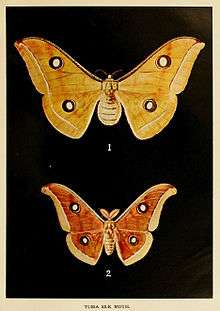Antheraea paphia
| Antheraea paphia | |
|---|---|
| Scientific classification | |
| Kingdom: | Animalia |
| Clade: | Euarthropoda |
| Class: | Insecta |
| Order: | Lepidoptera |
| Family: | Saturniidae |
| Genus: | Antheraea |
| Species: | A. paphia |
| Binomial name | |
| Antheraea paphia | |

Antheraea paphia, the South India small tussore, is a moth of the family Saturniidae found in India[1] and Sri Lanka.[2]
Description
The male is reddish or yellowish. Costal brown and grey fascia of forewings reaching the apex. Hyaline and ocellated spots (eyespots) are much larger than that of Antheraea roylei. The submarginal line of the hindwings close to the margin. There is no marginal yellow line. Female may be pinkish brown or bright yellowish fawn. Hyaline and ocellated spots are larger than male. Larva green colored with paired dorsal series of yellow humps. White lunulate spots on 5th and 6th somites have purple border, whereas a lateral yellow line from 7th somite ending in a dilated brown band on anal somite. Spiracles are yellow. The cocoon is brownish grey, hard, and oval, attached to the host plant by a silken peduncle.[3]
Ecology
The larvae feed on several trees such as Anogeissus latifolia, Terminalia tomentosa, T. arjuna, Lagerstroemia parviflora, and Madhuca indica, and the silk that composes their cocoons is sometimes used in the production of tussar silk.
References
- ↑ Maxwell-Lefroy, H., 1909. Indian Insect Life: a Manual of the Insects of the Plains. 1-786
- ↑ "Tussur Moth (Antheraea paphia) from Sigiriya central Sri Lanka". flickr.com. Retrieved 16 June 2016.
- ↑ Hampson, G. F. (1892). The Fauna of British India Including Ceylon and Burma: Moths. I. Taylor & Francis. Retrieved 29 September 2017.
| Wikimedia Commons has media related to Antheraea paphia. |